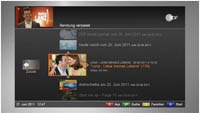HbbTV embraces MPEG DASH

The Hybrid Broadcast Broadband TV (HbbTV) consortium has reacted quickly to the growing momentum behind the recently published MPEG-DASH HTTP adaptive streaming standard by incorporating it within the latest version of its specification.
The consortium believes that, with the HTTP adaptive streaming support, it now has all the key ingredients for deployment of hybrid TV services combining broadcast with web content and interactive services. This is significant not just because it enables broadcasters to deliver content at higher quality over the Internet as part of hybrid services based on HbbTV, but also because it increases options for content protection. MPEG-DASH uses the Common Encryption Scheme (CENC) specifying standard encryption and key mapping methods that can be used by one or more Digital Rights Management (DRM) systems.
It operates with a common format for the encryption related metadata necessary to decrypt the protected streams, therefore enabling content to be encrypted just once for handling in principle by any DRM. This support for multiple DRMs is a key requirement for multi-screen services deployed to a variety of device platforms that may have different protection mechanisms for content.
HbbTV has been gaining momentum across Europe because it is seen as the best, emerging hybrid platform that builds on existing standards rather than imposing new ones on pay TV operators or broadcasters. It combines standards defined by the DVB for digital broadcasting, the Open IP TV Forum for IP-based transmission, the World Wide Web Consortium (W3C) for integrating video with web services via the HTML5 content presentation environment, and now MPEG DASH for the streaming and multiple DRM support on multiple screens.
The HbbTV consortium is also working with standards bodies in individual European countries, such as the Digital Technology Group (DTG) in the UK to incorporate some of the features of its UK Dbook7 PartA specifications relating to digital terrestrial transmission. The DTG has been itself working with standards bodies to ensure international commonality of Connected TV standards, and that they dovetail as well as possible with existing broadcast technologies. The DTG and HbbTV consortium are also concerned that hybrid broadcast and streaming standards are fully aligned with the UltraViolet (UV) download to own digital locker system promoted by DECE (Digital Entertainment Content Ecosystem) comprising Hollywood Studios, Consumer Electronics Makers, and content security companies among others. UV uses the same CENC encryption and Common File Format as MPEG DASH, with the two respectively emerging as the most likely multi-screen platforms to predominate for video download and streaming.
But, as Klaus Illgner-Fehns, Chair of the HbbTV consortium, pointed out, the latest version 1.5 of HbbTV was developed not just from the input of standards bodies but also from requests for specific features from the broadcast industry. This includes enhancements to broadcast TV schedule information to allow for full seven-day electronic program guides to be deployed across all compatible receivers.
“The publication of version 1.5 of the HbbTV specification responds to strong market demand for new features to be included as soon as possible,” said Illgner-Fehns.” We are already working towards version 2.0 of the specification.”
The professional video industry's #1 source for news, trends and product and tech information. Sign up below.
This may include more hooks for interactive applications including dynamic advertising.
As HbbTV continues to gather steam and make its presence felt even outside Europe, the main cloud on the horizon concerns the evolution of TV interactivity and the role companion screens play in this. It just could be that WiFi connected devices such as tablets provide the focal point for applications and for bringing web based content to the main TV, bypassing HbbTV.
